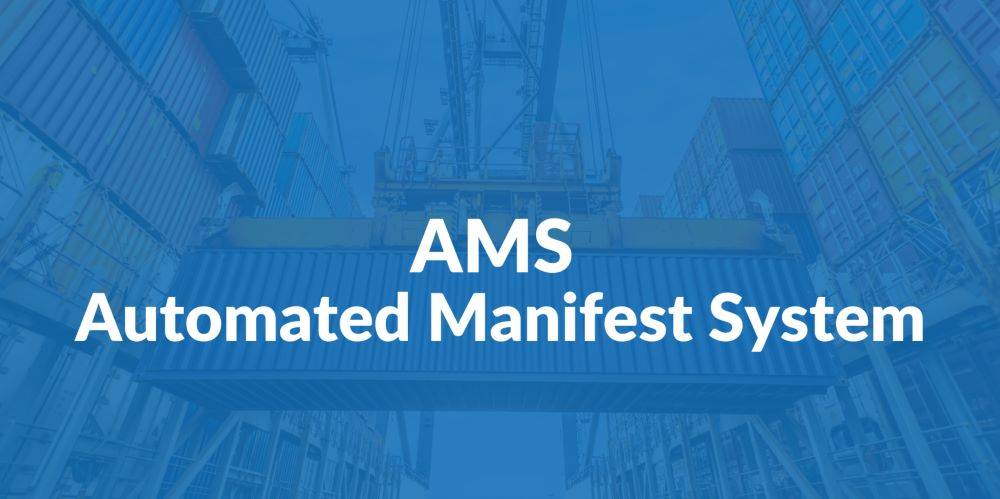2022-08-06
AMS (Automated Manifest System) and ENS (Entry Summary Declaration) are both terms related to customs procedures and international trade. They are often associated with the import and export of goods, helping to streamline processes and enhance security.
| Definition |
|---|
| The Automated Manifest System is a U.S. Customs and Border Protection (CBP) computerized system used for tracking, controlling, and processing information about goods being imported into the United States. |
| Functionality |
|---|
| AMS requires carriers, freight forwarders, and other transportation intermediaries to electronically submit cargo information before the goods arrive in the U.S. This electronic transmission of data allows customs authorities to pre-screen and assess the risk of incoming shipments, enabling more efficient and secure cargo clearance. |
| The freight forwarder must report the cargo and other information to the carrier 48 hours before departure. Carriers must report cargo information to the United States. Customs through AMS system 24 hours before departure, and must provide the real owner and consignee to the U.S.Customs. |
| Definition |
|---|
| The Entry Summary Declaration is a similar system used in the European Union for goods being imported into EU member states. |
| Functionality |
|---|
| ENS requires the submission of detailed information about the goods before they arrive at an EU port. This information includes details about the goods, their origin, destination, and other relevant data. Like AMS, ENS is designed to enhance security and facilitate smoother customs processes. |
| Since January 1, 2011, the EU will enforce the rule of “advance manifest declaration” for all shipments to or through EU ports, which is applicable to all 27 EU Member States.ENS shall be submitted 24 hours before loading at the port of departure. |
In summary, both AMS and ENS are automated systems that require the electronic submission of information about incoming shipments before they reach their destination. These systems aim to improve the efficiency of customs processes, enhance security by allowing authorities to identify and inspect high-risk shipments, and facilitate international trade by reducing delays in customs clearance.

AMS: The information primarily comes from the bill of lading and includes details such as House BL number, Carrier Master BL number, Carrier Name, Shipper, Assignee, Notify Party, Place of Receipt, Vessel/Voyage, Port of Loading, Port of Discharge, Destination, Container Number, Seal Number, Size/Type, No. & PKG Type, Weight, CBM, Description of Goods, Marks & Numbers. If the ACI (Advance Commercial Information) is wired, a CCN (Cargo Control Number) code may also be added.
ENS: Shipper, consignee, arrival notifier, container number, basic information of goods, customs code, gross weight, net weight, UN code of dangerous goods AMS: mainly the information in the bill of lading, including house BL number, carrier master BL no, carrier name, shipper, assignee, notify party, place of receipt, vessel / voyage, port of loading, port of discharge, destination, container number, seal number, size / type, No. & PKG type, weight, CBM, description of goods, Marks & numbers, If the ACI is wired, add a CCN code.
| AMS | ENS | |
|---|---|---|
| Origin | AMS is primarily associated with the United States and is used for shipments entering the U.S. | ENS is associated with the European Union and is used for shipments entering EU member states. |
| Data Elements | Data for AMS is often derived from the bill of lading and includes information such as House Bill of Lading (HBL) number, Carrier Master Bill of Lading (MBL) number, Carrier Name, Shipper, Assignee, Notify Party, Place of Receipt, Vessel/Voyage, Port of Loading, Port of Discharge, Destination, Container Number, Seal Number, Size/Type, No. & PKG Type, Weight, Cubic Measurement (CBM), Description of Goods, Marks & Numbers. | ENS requires information such as Shipper, Consignee, Arrival Notifier, Container Number, Basic Information of Goods, Customs Code, Gross Weight, Net Weight, and UN Code for Dangerous Goods. |
| Transport Document) | For certain shipments, especially those entering Canada, the submission of Advance Commercial Information (ACI) is required. This may include additional details such as a Cargo Control Number (CCN). | ENS may include specific security-related information to assess potential risks associated with the goods being imported. Information related to the transport document, such as the Bill of Lading or Air Waybill, is also a crucial part of ENS. |
Note: these are general distinctions, and specific requirements can vary by country and region. It's always advisable to consult the relevant customs authorities and regulations for the specific details and updates regarding AMS and ENS requirements.

According to the regulations of U.S. Customs, the freight forwarder closest to the direct exporter is required to send AMS information. However, in the domestic context, most forwarders are picked up by the shipping company or booking agent. In the process of delivery, due to uncertain customs regulations, service attitude, conflict of interest and lack of attention to AMS, customs clearance may be delayed or even fined.
Some people also call AMS 24-hour manifest forecast. As the name suggests, it is necessary to send the manifest 24 hours in advance. However, the shipping company or the freight forwarder for the same trade will ask for AMS information very early (the shipping company usually closes the customs three or four days in advance). For the exporter, the information given three or four days in advance may be incorrect, and once the customs is closed, the shipping company is required to change AMS.
In addition, 24 hours in advance is not limited by the sailing time. It should be required to get the receipt from the U.S. Customs 24 hours before the box is loaded on the ship (the freight forwarder gets OK / 1y, and the shipping company or wharf gets 69). There is no rule on how far in advance shipments can be made. No matter how early it is sent, it is useless not to get the correct receipt.
U.S. military materiel shall not be exempted
"Fake Dummy" bills of lading are not approved by U.S. Customs
General cargo descriptions are not permitted.
"To order Bills of Lading": The consignee, the owner or the owner's representative must be confirmed.
U.S. Customs does not allow containers to be loaded on board until the 24-hour deadline arrives.'
"FROB" (foreign cargo left on board when passing through a US port): the same requirement is made to declare a manifest.
Submission by port of loading: All goods must be submitted 24 hours before loading at the port of loading, rather than the final port of loading.
Empty containers: The new rules do not apply to empty containers, but participants in the automatic manifest declaration system must fill in the empty container number on the bill of lading and submit it before arriving at the U.S. port.
Change of manifest: (If the original registration data known to the registrant is correct and can be changed), it is necessary to comply with the customs regulations. However, the customer must be aware that any change to the original declaration information may affect the risk assessment of the goods by U.S. Customs and lead to the inspection of the goods.
A precise description of the goods (or a 6-digit HTS number if the cargo owner provides a classification of the goods), the weight of the goods or a general description of the goods and weight of the shipper of the sealed shipper, such as FAQ, General Cargo, Said to Contain, Chemicals, and Foodstuffs will not be accepted.
The full name and address of the shipper or the confirmation number granted by Customs to the shipper under the ACE (Automated Commercial Environment).
The full name and address or confirmation number of the consignee, cargo owner or cargo owner's agent.
The box number is banned.

This article provides a guide to international cargo insurance for cargo owners to help them choose the right insurance plan.
2023-04-24

A certificate of origin proves where goods originated and is often needed for international trade, helping to determine taxes, tariffs, and quotas.
2022-11-04

JIKE, an experienced and customer-oriented freight forwarding company, is the best choice for COD cash on delivery service to meet your needs.
2022-09-24
We use third-party cookies in order to personalise your experience.
Read our cookie policy